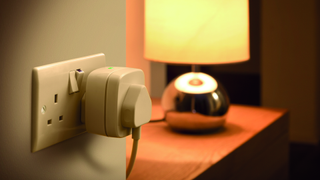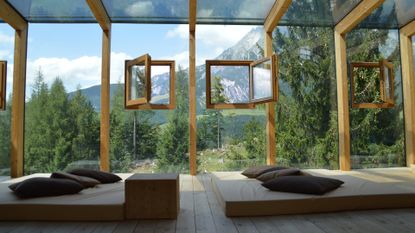Quick links
Jump straight to:
Open windows and doors
Close windows and doors – bet you didn't expect that one
Exhaust hot air
Remove heat sources
Conservatory cooling
Cooling the bedroom
Smarter solutions
Air conditioning
There is officially a heatwave on in the UK, with temperatures expected to become hotter than most Brits find ideal by Thursday. You need to cool your home, and you need to cool it fast. But what's the best way to cool your whole home, cool down your bedroom, or just cool yourself down in a smart way? Let's explore your options with some things you can do now, ways you can keep cool in the future, and methods to keep your bedroom cool.
- Need a quick fix? Try the best fans out there...
- ...or take it up a notch with a portable air conditioner
- Out and about? Here are the best cool boxes and bags
While we'll talk about air conditioning later, we're going to presume you want to cool your home without AC as a starting point. It's not hard as long as you follow best practice, some of which might seem counter-intuitive. But let's not stop there; we'll suggest some smart additions to those common practices, allowing you to automate your home cooling as much as possible, and some essential cooling gadgets to drop the temperature an extra few degrees.

How to cool your whole home fast: Close windows and doors
The sun is your enemy, and the air outside is hot. Keep your windows closed, because the insulation principle that keeps you warm in the winter should work both ways. Keep your internal doors closed, if you can, in order to focus your cooling on the rooms that matter; the fewer cubic metres of air you need to chill, the more efficient your cooling will be. Window and door sensors are good for more than just security in this case; they can alert you if a pesky family member is inadvertently letting the heat in.
Light means heat, so shut the blinds. Gloomy or not, you need to keep the sun out. If you have slatted blinds you may wish to angle them in such a way that they'll actively reflect the sun. Blackout blinds, or plain old roller blinds, need to be shut. Is this, at last, a true killer app for the extravagance of smart blinds or motorised blinds? Probably not. But treating yourself to an IKEA Fyrtur or Kadrilj smart blind will help you automate the process, and it'll absolutely leave your home cooler.
How to cool your whole home fast: Open windows and doors
The absolute opposite advice is true at those times of day when it's cool outside and hot inside. Use those times to let as much cool air in as possible. Open as many windows and doors as you can in the early morning or late at night, giving your home plenty of ventilation.

The Netatmo Smart Home Weather Station is a great way to see the precise temperature outdoors and in, and set up alerts when the external air temperature reaches a certain nadir, so you know it's time to throw those doors wide.
If there's no breeze, try one of our pick of the best fans to draw that cool air through your home.
How to cool your whole home fast: Exhaust hot air
Make use of the kit you already have installed. A bathroom or kitchen extractor fan is built to draw out air. Leave one running for a while to pull out the existing hot air once you've taken other precautions to stop it heating up again.
It will be tempting to set up a pedestal fan next to an open window. That's not such a bad idea, but you'll want to point that fan to blow out of the window, rather than towards you, to blow the hot air out; while the other way round offers a little blessed relief as the moving air goes over your skin, it'll end up warming your room in the long run if the air it's pulling in is hotter than what's already in your home.

How to cool your whole home fast: Remove heat sources
Anything that consumes electricity generates a small amount of heat (damn you, physics, and your pesky conservation of energy) which is exactly the thing we're fighting. Things like music amps and receivers can be big culprits, and we've all been guilty of leaving them plugged in and switched on at times. Use a smart plug to kill the power automatically at night or to conveniently switch off your kit when you're not using it; a network of smart plugs from the same brand can help you manage a bunch of equipment from a single app, or TP-Link's Kasa Power Strip KP303 gives you a useful three-outlet option.
Older-style light bulbs are other notorious radiators. If you've not already switched your home to full LED lighting, investing in the best smart bulbs isn't a bad idea. They're typically quite low energy, and (at least according to LIFX's own research) they often produce less heat than standard LED bulbs.
How to cool your whole home fast: Conservatory cooling
Many people are ripping the tops from their conservatories and installing a proper roof; given that the glass-box structure of a conservatory makes it a veritable greenhouse, that's not a huge surprise. We'd be tempted to shut off the conservatory entirely on the hottest summer days (and yes, we appreciate the irony) but adding good blinds can make a big difference.

For glass-topped conservatories, consider exterior-mounted blinds, which reflect that light and heat before it gets a chance to bounce around in your glazing. A polycarbonate roof benefits from solar reflectors; slide them between the roof layers and they'll bat away the heat in the summer and keep it safely inside in winter.
How to cool your whole home fast: Cooling the bedroom
Night time is a quiet time; some of us like the white noise of a fan, but some need silence. Ideally you'll want to get your bedroom cool in the daytime so it's a good temperature when you come to bed down. If you're able to decamp to a downstairs or even basement room in the summer months, even better. Heat rises, so the lower you can place yourself in the house the better.

Thankfully there's a lot you can do to sleep through the heat without the need for anything loud or too extreme. Actively, Dyson's Pure Cool Me or Pure Humidify + Cool are superb fans which are barely audible, and the former includes a built in sleep timer.
Try a mattress cooling pad to make your bed feel cool, or a mattress protector designed for cooling. You could even switch to an entirely new mattress, many of which are built to maintain a good temperature.
Top it all off with cotton sheets. There's nothing quite like cotton for a cool-feeling bed.
• Browse cotton sheets at John Lewis
• Browse cotton sheets at Amazon UK
• Browse cotton sheets at Amazon US
• Browse cotton sheets at Target
How to cool your whole home fast: Smarter solutions
Still struggling with the heat? A host of summer cooling gadgets exist that can help drop the temperature in a room, or at least bring your own personal temperature down.
You can also DIY yourself some personal coolers; ice in front of a fan does work surprisingly well as an evaporative cooler (meaning the heat energy in the air is used up melting the ice at stored in the water, taking it out of the air) without needing to put too much money into something like a Dyson fan (though we doubt you'll regret that particular purchase). Dampen yourself down and get some air over you. It works.
Getting really clever with your smart home kit can help with efficiency, too. Hooking your thermostat to smart plug-connected fans, activating certain devices only after the sun has dipped below the horizon, building yourself a whole home 'it's too hot' smart routine which can be activated by Alexa – whatever you can do with what you have at home, do it.

How to cool your whole home fast: Air conditioning
The availability and ubiquity of air conditioning really depends on where you are. In the US and Australia, many houses are built around central air; perhaps, if you're lucky enough to already have AC throughout your home, this guide isn't for you. Switch it on. Cool down. Even if there's no central air, many North American homes include a wall-mount air conditioner with outdoor
For the rest of us, AC is typically an add-on, because our climate is unlikely to get quite hot enough to warrant the hassle and expense of fully integrated AC. You simply won't use it for that half of the year where the weather is a lot more conducive to bolting your windows shut and putting on three jumpers.
If this is the route for you, you'll be looking for a solid portable air conditioner, one with enough grunt to actually cool the room you're likely to put it in. Compare your square footage with the BTU rating of the unit; the higher the BTU, the more cubic metres the AC unit will be able to cool.
There are big downsides. Air conditioners are noisy. They're not tremendously power efficient. The warm air they drag out needs to go somewhere, usually exhausting through a hose you dangle out of an open window; putting a portable air conditioner next to an open window means it's partially cooling air coming from outdoors, which is very silly. That's not to say you couldn't bore a hole in your wall for the exhaust, but that's not the most practical solution.
If you're lucky enough to have sash windows with the right dimensions, a window-mounted AC theoretically keeps the warm air out and the cool air in, so it's a highly efficient portable AC option.
Most, if not all, air conditioners include a thermostat so they only switch on when they're needed, which is good. That would include those times when you're not around, so make sure you connect your air conditioner to a smart plug -- preferably one with an energy monitor that can help you see just how much juice it's drawing.
They're few and far between, but you can also find smart air conditioners out there. The extra app control is a nice feature to have, particularly if you're looking to hit that temperature sweet spot without leaving the sofa, but it's not absolutely essential.



